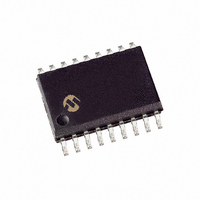PIC16F716-I/SO Microchip Technology, PIC16F716-I/SO Datasheet - Page 657

PIC16F716-I/SO
Manufacturer Part Number
PIC16F716-I/SO
Description
IC PIC MCU FLASH 2KX14 18SOIC
Manufacturer
Microchip Technology
Series
PIC® 16Fr
Datasheets
1.PIC16F616T-ISL.pdf
(8 pages)
2.PIC16F688T-ISL.pdf
(688 pages)
3.PIC16F716-ISO.pdf
(136 pages)
4.PIC16F716-ISO.pdf
(12 pages)
5.PIC16F716-ESO.pdf
(126 pages)
Specifications of PIC16F716-I/SO
Program Memory Type
FLASH
Program Memory Size
3.5KB (2K x 14)
Package / Case
18-SOIC (7.5mm Width)
Core Processor
PIC
Core Size
8-Bit
Speed
20MHz
Peripherals
Brown-out Detect/Reset, POR, PWM, WDT
Number Of I /o
13
Ram Size
128 x 8
Voltage - Supply (vcc/vdd)
2 V ~ 5.5 V
Data Converters
A/D 4x8b
Oscillator Type
Internal
Operating Temperature
-40°C ~ 85°C
Processor Series
PIC16F
Core
PIC
Data Bus Width
8 bit
Data Ram Size
128 B
Interface Type
RS- 232/USB
Maximum Clock Frequency
20 MHz
Number Of Programmable I/os
13
Number Of Timers
3
Operating Supply Voltage
2 V to 5.5 V
Maximum Operating Temperature
+ 85 C
Mounting Style
SMD/SMT
3rd Party Development Tools
52715-96, 52716-328, 52717-734
Development Tools By Supplier
PG164130, DV164035, DV244005, DV164005, PG164120, ICE2000
Minimum Operating Temperature
- 40 C
On-chip Adc
4-ch x 8-bit
Package
18SOIC W
Device Core
PIC
Family Name
PIC16
Maximum Speed
20 MHz
Lead Free Status / RoHS Status
Lead free / RoHS Compliant
For Use With
XLT18SO-1 - SOCKET TRANSITION 18SOIC 300MILI3-DB16F716 - BOARD DAUGHTER ICEPIC3AC162054 - HEADER INTERFACE ICD2 16F716AC164010 - MODULE SKT PROMATEII DIP/SOIC
Eeprom Size
-
Connectivity
-
Lead Free Status / Rohs Status
Lead free / RoHS Compliant
Available stocks
Company
Part Number
Manufacturer
Quantity
Price
Company:
Part Number:
PIC16F716-I/SO
Manufacturer:
MICROCHI
Quantity:
42
Part Number:
PIC16F716-I/SO
Manufacturer:
MICROCHIP/微芯
Quantity:
20 000
- PIC16F616T-ISL PDF datasheet
- PIC16F688T-ISL PDF datasheet #2
- PIC16F716-ISO PDF datasheet #3
- PIC16F716-ISO PDF datasheet #4
- PIC16F716-ESO PDF datasheet #5
- Current page: 657 of 688
- Download datasheet (3Mb)
A.3
1997 Microchip Technology Inc.
Transfer Acknowledge
SDA
SCL
Condition
Start
S
All data must be transmitted per byte, with no limit to the number of bytes transmitted per data
transfer. After each byte, the slave-receiver generates an acknowledge bit (ACK)
When a slave-receiver doesn’t acknowledge the slave address or received data, the master must
abort the transfer. The slave must leave SDA high so that the master can generate the STOP con-
dition
Figure A-4:
If the master is receiving the data (master-receiver), it generates an acknowledge signal for each
received byte of data, except for the last byte. To signal the end of data to the slave-transmitter,
the master does not generate an acknowledge (not acknowledge). The slave then releases the
SDA line so the master can generate the STOP condition. The master can also generate the
STOP condition during the acknowledge pulse for valid termination of data transfer.
If the slave needs to delay the transmission of the next byte, holding the SCL line low will force
the master into a wait state. Data transfer continues when the slave releases the SCL line. This
allows the slave to move the received data or fetch the data it needs to transfer before allowing
the clock to start. This wait state technique can also be implemented at the bit level,
Figure A-5:
MSB
1
(Figure
Address
2
A-1).
Slave-Receiver Acknowledge
Data Transfer Wait State
acknowledgment
signal from receiver
Transmitter
7
Output by
Output by
SCL from
Receiver
Master
Data
Data
R/W
8
Condition
Start
S
ACK
9
byte complete
interrupt with receiver
Wait
State
1
clock line held low while
interrupts are serviced
1
2
not acknowledge
acknowledge
Data
2
8
Acknowledgment
Clock Pulse for
3 8
acknowledgment
signal from receiver
Appendix A
9
ACK
9
DS31034A-page 34-5
Condition
Stop
P
(Figure
Figure
A-4).
A-5.
34
Related parts for PIC16F716-I/SO
Image
Part Number
Description
Manufacturer
Datasheet
Request
R

Part Number:
Description:
IC PIC MCU FLASH 2KX14 18DIP
Manufacturer:
Microchip Technology
Datasheet:

Part Number:
Description:
IC PIC MCU FLASH 2KX14 18DIP
Manufacturer:
Microchip Technology
Datasheet:

Part Number:
Description:
IC PIC MCU FLASH 2KX14 20SSOP
Manufacturer:
Microchip Technology
Datasheet:

Part Number:
Description:
IC PIC MCU FLASH 2KX14 18SOIC
Manufacturer:
Microchip Technology
Datasheet:

Part Number:
Description:
IC PIC MCU FLASH 2KX14 28QFN
Manufacturer:
Microchip Technology
Datasheet:

Part Number:
Description:
3.5 KB Flash, 128 RAM, 13 I/O 28 QFN 6x6mm TUBE
Manufacturer:
Microchip Technology
Datasheet:

Part Number:
Description:
IC,MICROCONTROLLER,8-BIT,PIC CPU,CMOS,SSOP,20PIN,PLASTIC
Manufacturer:
Microchip Technology
Datasheet:

Part Number:
Description:
8-bit Flash-based Microcontroller with A/D Converter and Enhanced Capture/Compare/PWM
Manufacturer:
Microchip Technology
Datasheet:

Part Number:
Description:
IC, 8BIT MCU, PIC16F, 32MHZ, SOIC-18
Manufacturer:
Microchip Technology
Datasheet:

Part Number:
Description:
IC, 8BIT MCU, PIC16F, 32MHZ, SSOP-20
Manufacturer:
Microchip Technology
Datasheet:

Part Number:
Description:
IC, 8BIT MCU, PIC16F, 32MHZ, DIP-18
Manufacturer:
Microchip Technology
Datasheet:

Part Number:
Description:
IC, 8BIT MCU, PIC16F, 32MHZ, QFN-28
Manufacturer:
Microchip Technology
Datasheet:

Part Number:
Description:
IC, 8BIT MCU, PIC16F, 32MHZ, QFN-28
Manufacturer:
Microchip Technology
Datasheet:

Part Number:
Description:
IC, 8BIT MCU, PIC16F, 32MHZ, QFN-28
Manufacturer:
Microchip Technology
Datasheet:

Part Number:
Description:
IC, 8BIT MCU, PIC16F, 32MHZ, SSOP-20
Manufacturer:
Microchip Technology
Datasheet:











